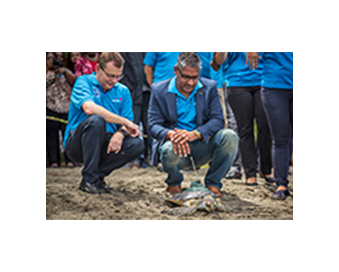The first-ever initiative to use satellite telemetry to track the migratory patterns of hard shell sea turtles from Trinidad and Tobago was launched on October 12 in Grande Riviere by LNG producer Atlantic and the Turtle Village Trust (TVT).
At the launch event for the historic Atlantic/TVT Geo-tagging Project, three (3) juvenile hard shell turtles who for 2 years were “residents” of the Nest Relocation and Hatchery Programme were released back in to the sea. The turtles – lovingly dubbed “Trini T”, “Quaddie” and “Spirit” by Atlantic’s employees – were each fitted with a state-of-the-art satellite transmitter. These transmitters will relay signals to orbiting satellites, enabling the TVT and the Grande Riviere Nature Tour Guides Association (GRNTGA) to track the turtles’ migrations. A total of 20 transmitter devices will be deployed this year.
Atlantic CEO Nigel Darlow hailed the Geo-tagging Project as a ground-breaking initiative in turtle conservation, and critical to providing previously unavailable data that would bolster local efforts to protect the sea turtle population.
“Researchers will be able to track the geographic location of the tagged sea turtles and find out where they are going – something we have not been able to do before with green turtles and hawksbill turtles,” Darlow said. ”And I think with that type of data, the local communities and local groups can help fill in some of the information gaps related to what happens to these turtles when they are out at sea. And hopefully by tracking their migration patterns, and understanding and following this data then we will know how better to protect them and avoid some of the challenges from human activities that they face.”
Minister of Agriculture, Land and Fisheries Clarence Rambharat described the Atlantic/Turtle Village Trust Geo-tagging Project as a landmark initiative that demonstrated the importance of collecting data that would help the government create relevant policies and legislation for turtle conservation.
“It is an absolute joy to see the work that has been undertaken by Atlantic, the Turtle Village Trust and the community of Grande Riviere,” Minister Rambharat said. “This says a lot in terms of the recognition that we can only make the appropriate public policy and legislative decisions if we are informed by proper research and data. As beautiful as the turtles are, as interesting as they are to look at in captivity, as interesting as it would be to release them, the ultimate objective is to gather data to make informed decisions that will allow for the future protection of these species.”
Derek Daniel, Chairman of Turtle Village Trust explained that the transmitter devices could provide data for up to nine months and would be tracked by the ARGOS Satellite-Tracking System.
“The transmitters will give us real-time data of each turtle’s geo-location,“ Daniel said. “With the geo-location coordinates, we can plot their migratory routes, map out their feeding zones, analyze the mating and nesting cycle and even begin to understand the patterns of how turtles use the habitat in the different territories to which they migrate. ”
At the launch event, an additional four green turtles from the Hatchery Programme were released without satellite transmitters back into the sea by Atlantic Sports Ambassadors George Bovell, Andrew Lewis, Kieron Pollard and Sunil Narine, witnessed by excited children and members of the Grande Riviere community.
The Atlantic/Turtle Village Trust Geo-tagging Project follows the successful Nest Relocation and Hatchery Programme which Atlantic established in 2015 in partnership with TVT and the Grande Riviere Nature Tour Guides Association (GRNTGA). In the Nest Relocation and Hatchery Programme, eggs of hawksbill and green turtles are relocated from their nests and placed in a turtle hatchery, which gives them a safe incubated environment. After some 60 to 70 days in incubation, the hatchlings are moved into confined tanks with sea water circulating, where they are fed and monitored for up to a year, until they grow bigger and become juveniles, and are then released back into the sea.
Atlantic is the sole sponsor of the National Sea Turtle Tagging and Monitoring Programme, an initiative of the Turtle Village Trust which gathers information about the population of nesting leatherbacks, hawksbill and green turtles in Trinidad and Tobago; and about the resident population of hawksbill and green turtles foraging on the reefs and sea grass beds around Tobago. The data gathered by the Turtle Village Trust and its partner turtle communities contributes to the overall management of sea turtles locally, regionally and globally.
Photo Caption
Nigel Darlow, CEO, Atlantic and Hon. Clarence Rambharat, Minister of Agriculture, Land and Fisheries encourage “Trini T”, the first of three green turtles fitted with satellite transmitters and returned to the sea at the Oct 12 launch of the Atlantic/Turtle Village Trust Geo-Tagging Project. The Project will use satellite telemetry to track the migratory patterns of hard shell sea turtles from Trinidad and Tobago.



